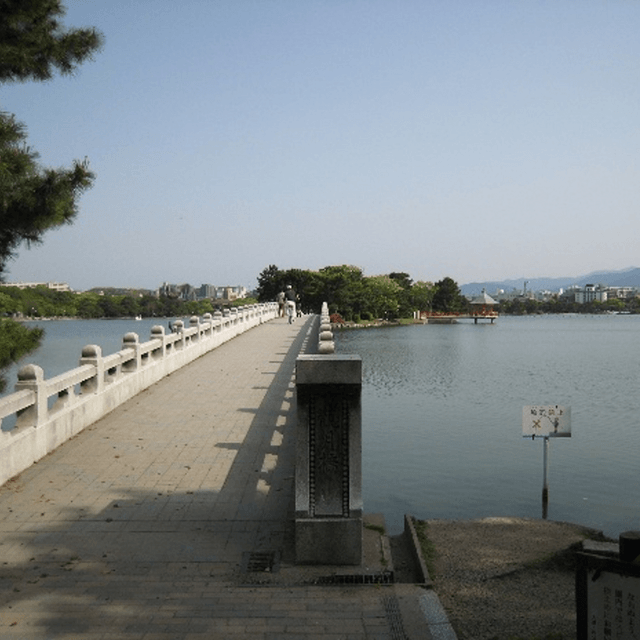
大濠公園は昭和4(1929)年に開園しました。福岡城の西側に広がっていた「大堀」を整備した公園で、開園前の昭和2(1926)年には東亜勧業博覧会、また昭和50(1975)年には福岡大博覧会の会場となりました。公園全体が国登録の名勝となっています。
堀濠にかかる5つの橋「大濠公園観月橋・松月橋・茶村橋・舞鶴橋・浮見堂」は福岡市の有形文化財に登録されています。
大濠公園の濠に突き出して建てられている六角形のお堂「浮見堂」は戦前、東公園にあった福岡市立動植物園にあった施設です。これはオットセイなどの海獣を見るための建物でしたが昭和19(1944)年に動物園は閉鎖し、戦後、空襲を逃れた浮見堂を保存しようという市民の声で昭和24(1949)年 に現在地 に移築されました。こちらも平成26(2014)年に市の有形文化財に登録されました。
園内には福岡市美術館や日本庭園、カフェや遊具があり、市民の憩いの場となっています。
The park opened in 1929 (Shōwa 4). As the “Ōhori” (large moat) that once spread to the west of Fukuoka Castle was being developed into a park and residential district, it served as a venue for the East Asia Industrial Promotion Exposition in 1926 (Shōwa 2) and for the “Fukuoka Grand Exposition” in 1975 (Shōwa 50). The moat area of the park is a nationally Registered Monument. Of the five bridges spanning the moat, four retain their original appearance, and the five items—“Ohori Park Kangetsu-bashi, Shōgetsu-bashi, Chamura-bashi, Maizuru-bashi, and Ukimi-dō”—are registered by Fukuoka City as Tangible Cultural Properties (structures).
The hexagonal pavilion “Ukimi-dō,” which projects over the park’s waters, was a prewar facility of the Fukuoka Zoo and Botanical Garden when it was located in Higashi Park. The structure was used for viewing marine mammals such as fur seals. The zoo closed in 1944 (Shōwa 19), and after the war, responding to citizens’ wishes to preserve the Ukimi-dō—which had escaped the air raids—the pavilion was relocated to its present site in 1949 (Shōwa 24) and was registered as a cultural property in 2014 (Heisei 26).
Within the park are the Fukuoka Art Museum, a Japanese garden, cafés, and playgrounds, making it a beloved place of relaxation for city residents.
スタンプを獲得すると、限定の壁紙をゲットできます。
スタンプを集めてね / Collect a stamp
限定の壁紙を獲得しました。
以下のボタンから壁紙を表示し、長押しで”写真”に保存してください。
